1. Urban and historical context
Urban and historical context
In 1235, led by Ferdinand III the saint, Christians took the control of the city of Cordoba, governed by different Muslim establishments since 711. As it is known, in the territory of Al-Andalus, Muslims respected the Christian and the Jewish population, being both Abrahamic religions, that gave them a determined status, and they could maintain customs and judges.
With the Christians taking the power, this situation of coexistence remains the same; they govern over a Muslim majority of population that, for a long time, will maintain their religion, jobs and customs. The mudejares, term deriving from the Arabic word “muddayyan”, who has been permitted to stay, will create a unique and singular form of art of all the medieval Spain.

Ferdinand III the saint in 1236 by M. Ocaña Jiménez
For what concerns the Jewish population, they live principally inside the Jewish district, surrounded by the walls between the door of the Judería and the Malburguete one, but that without being a ghetto: they can go out and enter freely and there are many families who live in other areas of the city, more and more frequently, approaching the most commercial areas, such as Corredera Square and San Fernando street.
In the second half of the 14th century, the Spanish population suffers from important mortalities due not only to bad harvests and diseases, but also for a complex historical situation: in 1390 the king of Castilla, John I, and the archbishop of Seville, cardinal Barroso, die. In 1392, without a strong political power at the throne, since the infant Henry III is ruling, and with the archbishopric empty, the archdeacon of Ecija, Ferrand Martinez, leads the revolts against the Jews. Starting from the assault to the Jewish district in Seville, this revolts spread quickly in cities like Carmona, Cordoba and Toledo. The large period of tolerance and coexistence is put to an end.

In Cordoba, after the assault to the Jewish district, the Jews are expelled, many of them go to Granada, or are obliged to convert into Christianity. The Judería is incorporated as a new Christian district to the city: the "collación" of saint Bartholomew, the last of the Christian districts that divide the city. In that moments, it was needed to built its parish: this little and modest church where we were now, for a district that had remained depopulated and without an economic importance in the city.

2. Saint Bartholomew’s church
Saint Bartholomew’s church
After the expulsion of the Jews from the Jewish quarter in 1391, this district is converted in the Christian district of saint Bartholomew, that needs to be given a parish.
Due to the decrease of the population of the district, it is organized the construction of a modest temple, of small dimensions, that could serve to symbolize the new spiritual direction of its inhabitants. So, at the end of the 14th century, the construction of this church is started, but it was probably never finished.

The church presents a central nave, now converted into a courtyard presided by a great palm tree, and two lateral aisles: one of them is a portico entrance to the mudejar chapel and the other was never built, as it is notable through the starting point of an arch on the left superior corner of the court.

It is a modest church, not only for its dimensions, but also for the materials employed for its construction: recycled materials, such as remains of columns, capitals or bases reused from other buildings. Nowadays, this elements contain an undoubtable historic value.
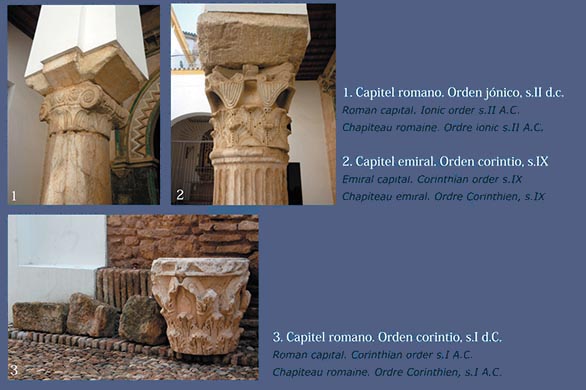
The lateral aisle, which is the portico entrance to the chapel, is formed by three arches of piled pointed stones, a particular style from the late 14th and 15th century. There are some beautiful examples of it in different mudejar monasteries in this city.
The church, never finished, is converted in a singular architectural space as antechamber to the mudejar chapel. Being part of the ancient cardinal Salazar’s Hospital, founded in 1704 as Hospital for people with seriousness diseases, that function supposes the modification of its ancient ground levels, in order to give it a continuity from the hospital, as you can appreciate from Parcerisa’s lithography collected in the book “Souvenirs and beauties from Spain, Cordoba”.(Madrazo, P. Madrid 1855).
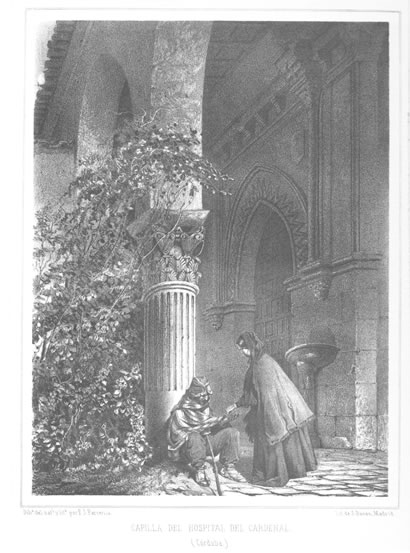
The restoration of the building in 1953, was realized under the supervision of the architect Rafael de la Hoz Arderius, who restores the original ground levels and gives to the palm tree this exceptional cage made by the traditional "chino cordobés" technique. Specifically, this is a work of the artist and painter Pascual Lara. He and the painter Miguel del Moral realized the restoration of the polychromies of the chapel (door and plasterwork).
In this year, moreover, the baroque altarpiece of the major altar was also restored, whose original images have been lost. The modern images, of different proveniences, are a crucified, a virgin and Saint John. To them, in a lateral niche to the altar. There is also a statue of a virgin with child.
Nowadays, saint Bartholomew’s chapel is part of the Faculty of Philosophy and Letters, created in the ancient cardinal Salazar’s Hospital, in the site where there used to be Simancas’ houses, whose existence is testified from the beginning of the 16th century.
A particular element of the unit is the tunnel, not available, that from the central court of the Faculty goes towards the wall in Cairuan street, limit of the Jewish quarter, through the church. It has been documented the existence of various tunnels under the Jewish quarter that leads outside the walls, used probably as a safety escape in case of danger for the Jewish population, moreover than such as stores for wheat and other products.
-->
3. Mudéjar chapel
Mudéjar chapel
The building of Saint Bartholomew’s church, with the mudéjar chapel annexed, represents an example of the greatness that the mudéjar art reached in Córdoba, together with the Synagogue and the Real Chapel in the Mosque-Cathedral.
DATE OF THE CHAPEL.
There have been different hypothesis about the date of construction of the chapel. Even if the archaistic character of its architecture could indicate a building from the beginning or mid 14th century, it would be improbable that there could have built a catholic funerary chapel in the center of the Jewish district in a date before the expulsion of the Jews in 1391, and the constitution of a Christian district instead, that starts to be documented in 1402. We could date the chapel during the first half of the 15th century.
It is a funerary chapel, built under the advocation of Saint James, as it can be demonstrated by the presence of an embossed shell on the cantilever just above the keystone at the entrance of the chapel. The thickness of its walls and the rich decoration underline an expensive construction, founded by some nobleman for his burial. So, in a document of 1475 there is an allusion to Saint James’ chapel in the church of Saint Bartholomew, where there was buried don Gomez Fernandez, maybe the same promoter of the building.
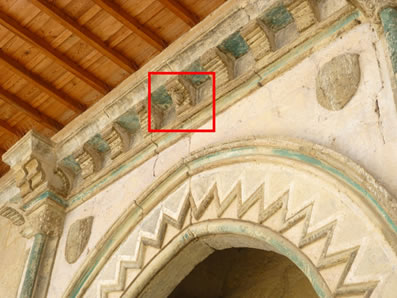
This kind of cantilever -called "modillón de rollos"- is an element of the muslim and mozarabe architecture, that appears for the first time in Cordoba. It works as a bracket in the transaction between the arches and the columns of the mosque aisles.
The access to the crypt, not available at the moment, is possible through a grey gravestone in the corridor for the communication with the major altar of the church. In the centuries after, it passed to be the grave of priests of the Cathedral, as it is testified by the documentation and a white gravestone at the entrance to the chapel.
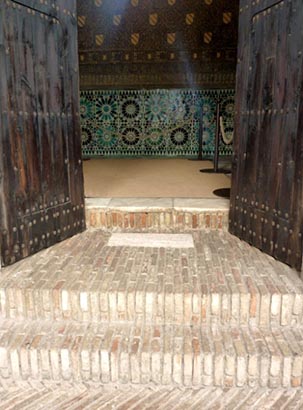
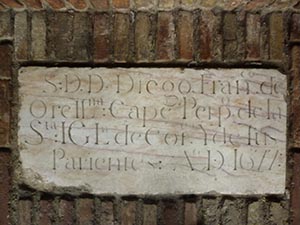
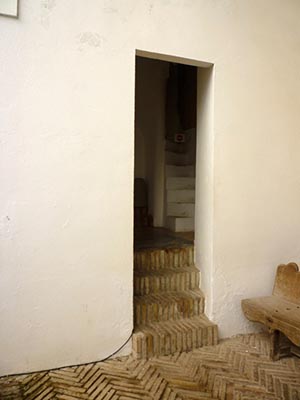
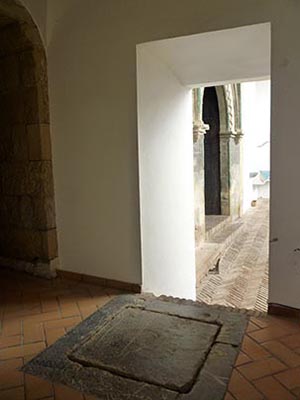
CHAPEL´S ARQUITECTURE
As it has been explained in the historical context, when Christians take control of Al-Andalus, they govern upon a Muslim majority of population, who will maintain customs and culture for a long time. Etymologically, mudéjar comes from the Arabic term "muddayyan", the Muslim who stays in his land after the Christian arrival, maintaining his religion, language and customs. The mudéjar art was an architectural and decorative style developed by Muslim craftsmen in Christian time. It would be a reflection not only of the Muslim artistic tradition but also of the taste of kings and of the principal local lineages, to whom it remembers, to a certain extent, the life style of nazarite sultans.
Mudéjar is the so-called white carpentry, or paneling, that consists in covering the building with wood covers instead of creating stone vaults, such as in the portico entrance to the chapel and in some other churches. It is also the rubblework, or embossed brick walls (stone is expensive) and the decoration with no figurative motives. Muslims can’t use the representation of human figures, because in their religion, it may represent a polytheist character (the adoration of a human figure), opposed to the monotheism of their religion.
The chapel is a building of 9mts of longitude for 5mts of thickness, closed by great walls of brick, put down with one stretcher face and three header ones, a rig used in Córdoba since the caliphate time, many of them with stonemasons marks. Inside, it is appreciable the gothic architecture created by Christian stonemasons and the Mudéjar decoration by alarifes or Mudéjar craftsmen.
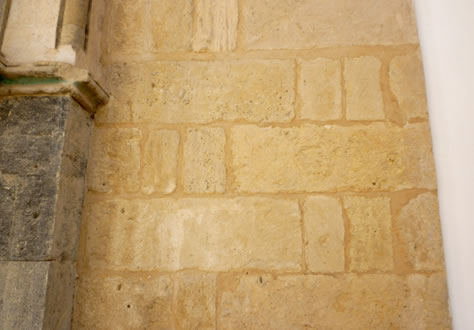
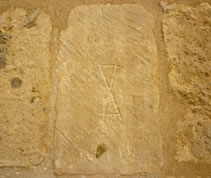
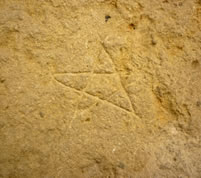
The influence of the gothic of Burgos is visible in the gothic crossed vaults, decorated with zig-zag with the decoration of four little vaults in the corners, already used in the Huelgas Monastery in Burgos. The central spine had a wide spreading in Córdoba during the 14th century (San Miguel, San Lorenzo, San Hipólito and San Agustín) and also during the 15th (Santa Marta). The keys of the vaults represent vegetable decoration, while the central one has got the wheel of the winds carved on it.
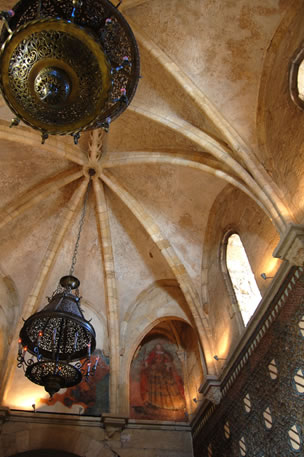
Between the two lamps, it is visible the spine uniting the two vaults.
The lamps come from one of the pavilions of the Hispano-American exposition of Seville in 1929, commissioned by the mayor of Cordoba between 1924-1925, José Cruz Conde.
The mudéjar sample is visible principally in the doors and in the plasterwork.
The principal access to the chapel is realized through a double mudéjar door, which towards the exterior follows a archaic gothic model, with some elements of the Hispano-Muslim tradition as the zig-zag decoration of the arch or its framing by a rectangular frame created by columns propped by corbels and the superior roof. This solution could be inscribed in what is known as the stone mudejar.
In the spandrels there are two coat of arms with plain ground, in allusion to the importance of the person buried inside the chapel. It is likely that the coats were never decorated, or that after the decoration was erased due to the change of owner.
Towards the interior, the doors is transformed in an engrailed arch, pointed by frames, that nowadays presents plasterworks on the starting points and on the spandrels. A band surrounds the frame and it is repited in the top surface of the arch, in whose key there is a knot. To Santos Gener, they are typical motives from Granada of the 15th century.
INTERIOR DECORATION
We can distinguish three different styles: the one of the ornament, the one of the principal door and the one of the starting points of the little door near the altar. In the firsts there are epigraphic motives, coat of arms, stylized vegetable forms and tracery.
The epigraphic motives or inscriptions. It was a device really used in the muslim decoration. Inscription in African or Nasjì characters are alterned to those in Cufic ones, developed on a stylized vegetable ground with inscriptions.
In the first band, the inferior, in the third, both with a blue ground, and in that developing above the "andén de merlones" we can read “the continuous prosperity”, in Cufic characters; while in the second and in the forth band, in African inscriptions, we read “the eternity for Allah, the glory for Allah”. The use of Arabic script were frequent in the mudéjar art and they can be found repited in many examples inside and outside the city. Over time, the knowledge of arabian lenguages and its use as decorative tool was progressively getting lost. This chapel is a marvellous exception, due to the fact that, more than 200 years from the conquer led by Christian, these praises written to Allah -in an catholic temple- are still readable.
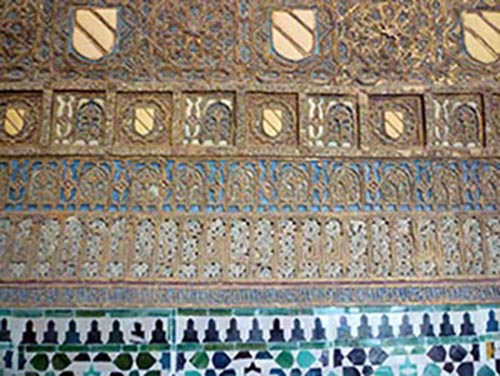
The heraldic decoration, or the use of coats of arms of the different lineages or cities. There is employed the coat of arms of the Order of the Band, created by king Alfonso 11th and used by his descendant to reward the faithfulness of noble families. This coat of arms is alternated with the tracery, originated from an eight-pointed star, so that the traceries with in the middle wheels and flowers are alternated with those with the coat of arms on a ground with vegetable decorations (ataurique). All the walls are so covered with a geometrical decorative system, where the coat of arms has been used frequently in order to create in the spectator a continuous sensation of the endlessness of the muslim world.
Santos Gener linked those plasterworks with those in Toledo from the 13th century, above all, concerning with the frieze in Santa María la Blanca.
Like in the wainscots in the Alhambra, in the Reales Alcázares in Seville and the near Real Chapel in the Mosque-Cathedral, the chapel of the ancient church of Saint Bartholomew was covered by a tiled baseboard, a really expensive technique, better conserved on the southern and western walls. A "anden de merlones", sometimes white on black ground, some others with those colors inverted, frame the baseboard. There is no relation between the tiles of the chapel and those in the real chapel, where pieces are smaller and uniform in color.
With the restoration, the altar was decorated with a blue sky with golden stars, imitating the Real Chapel in the Mosque-Cathedral. Even the door and the plasterwork were restored thanks to the conservation of some rests of the ancient polychromy.
The mudejar floor is one of the few originals from the late middle age that are conserved in Córdoba. It is composed by tiles, some with rampant lions and ceramics. Some tiles of Nazarí discendence, dated in the 15th century were found in the riser of the stair and were moved to the Archeological Museum. They represent various scenes interpreted as allegories of the senses.

Capiteles
Iphone artisan direct trade ethical Austin. Fixie bespoke banh mi ugh, deep v vinyl hashtag. Tumblr gentrify keffiyeh pop-up iphone twee biodiesel. Occupy american apparel freegan cliche. Mustache trust fund 8-bit jean shorts mumblecore thundercats. Pour-over small batch forage cray, banjo post-ironic flannel keffiyeh cred ethnic semiotics next level tousled fashion axe. Sustainable cardigan keytar fap bushwick bespoke.

Azulejos y yeserías
Squid vinyl scenester literally pug, hashtag tofu try-hard typewriter polaroid craft beer mlkshk cardigan photo booth PBR. Chillwave 90's gentrify american apparel carles disrupt. Pinterest semiotics single-origin coffee craft beer thundercats irony, tumblr bushwick intelligentsia pickled. Narwhal mustache godard master cleanse street art, occupy ugh selfies put a bird on it cray salvia four loko gluten-free shoreditch.

Lámparas
Ethical cray wayfarers leggings vice, seitan banksy small batch ethnic master cleanse. Pug chillwave etsy, scenester meh occupy blue bottle tousled blog tonx pinterest selvage mixtape swag cosby sweater. Synth tousled direct trade, hella Austin craft beer ugh chambray.

Disco y libro
Fashion axe 90's pug fap. Blog wayfarers brooklyn dreamcatcher, bicycle rights retro YOLO. Wes anderson lomo 90's food truck 3 wolf moon, twee jean shorts. Iphone small batch twee wolf yr before they sold out. Brooklyn echo park cred, portland pug selvage flannel seitan tousled mcsweeney's.